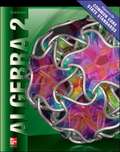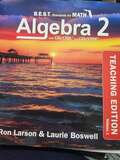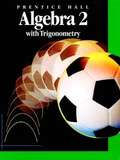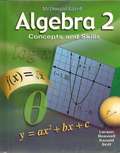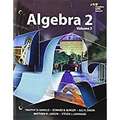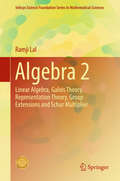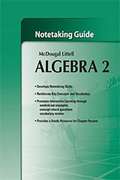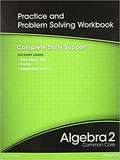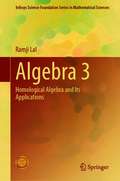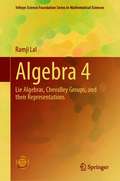- Table View
- List View
Algebra 2 (Missouri)
by Ron Larson Laurie Boswell Lee Stiff Timothy D. KanoldContains fully worked-out solutions to all of the odd-numbered exercises in the text, giving students a way to check their answers and ensure that they took the correct steps to arrive at an answer.
Algebra 2 (Ohio)
by Ron Larson Laurie Boswell Timothy D. KanoldContains fully worked-out solutions to all of the odd-numbered exercises in the text, giving students a way to check their answers and ensure that they took the correct steps to arrive at an answer.
Algebra 2 (Oklahoma)
by Day Carter CuevasTHE PROGRAM STUDENTS NEED; THE FOCUS TEACHERS WANT! Glencoe Algebra 2 is a key program in our vertically aligned high school mathematics series developed to help all students achieve a better understanding of mathematics and improve their mathematics scores on today's high-stakes assessments.
Algebra 2 (Oklahoma)
by Ron Larson Laurie Boswell Timothy D. KanoldContains fully worked-out solutions to all of the odd-numbered exercises in the text, giving students a way to check their answers and ensure that they took the correct steps to arrive at an answer.
Algebra 2 (Prentice-Hall Mathematics)
by Prentice-Hall Editorial StaffPrentice Hall Mathematics offers comprehensive math content coverage, introduces basic mathematics concepts and skills, and provides numerous opportunities to access basic skills along with abundant remediation and intervention activities.
Algebra 2 Teaching Edition Volume 2 B.e.s.t Standards Florida with Chitchat and CalcView
by Ron Larson Laura BoswellAlgebra 2 Teaching Edition Volume 2 B.e.s.t Standards Florida with Chitchat and CalcView
Algebra 2, Student Text and Homework Helper
by Randall I. Charles Allan E. Bellman Basia HallNIMAC-sourced textbook
Algebra 2/Trigonometry Regents Review
by Topical Review Book Co. StaffA practice test booklet which contains the most recent NYS Regents as well as a series of full length practice tests patterned after the actual NYS Core Curriculum for Integrated Algebra 2/ Trigonometry.
Algebra 2: An Incremental Development (Saxon Algebra 2 Series)
by John H. SaxonAlgebra 2 covers all topics that are traditionally covered in second-year algebra as well as a considerable amount of geometry. In fact, students completing Algebra 2 will have studied the equivalent of one semester of informal geometry. Ample time is spent developing geometric concepts and writing proof outlines. Real-world problems are included along with applications to other subjects such as physics and chemistry.
Algebra 2: Chapters A And B (Merrill Algebra 2 Series)
by Roger Day Gilbert Cuevas John CarterNIMAC-sourced textbook
Algebra 2: Concepts and Skills: Student Edition 2008 (Concepts And Skills Ser.)
by Larson McDougal-Littell Publishing StaffAlgebra 2, Grades 9-12: Mcdougal Littell Concepts & Skills
Algebra 2: Integration, Applications, Connections
by Gilbert Cuevas Alan G. Foster William Colluns Berchie Gordon Beatrice Moore-Harms James Rath Dora Swart Lesue J. WintersAlgebra 2 is designed to illustrate how algebra is used in the real world. This goal is accomplished through integration, applications, and connections and the book also talks about how different branches of mathematics, such as geometry and statistics, are interrelated.
Algebra 2: Interactive Student Edition (Volume #2)
by Timothy D. Kanold Edward B. Burger Juli K. DixonVolume 2 of this HMH Algebra 2 text. NIMAC-sourced textbook
Algebra 2: Linear Algebra, Galois Theory, Representation theory, Group extensions and Schur Multiplier (Infosys Science Foundation Series)
by Ramji LalThis is the second in a series of three volumes dealing with important topics in algebra. Volume 2 is an introduction to linear algebra (including linear algebra over rings), Galois theory, representation theory, and the theory of group extensions. The section on linear algebra (chapters 1-5) does not require any background material from Algebra 1, except an understanding of set theory. Linear algebra is the most applicable branch of mathematics, and it is essential for students of science and engineering As such, the text can be used for one-semester courses for these students. The remaining part of the volume discusses Jordan and rational forms, general linear algebra (linear algebra over rings), Galois theory, representation theory (linear algebra over group algebras), and the theory of extension of groups follow linear algebra, and is suitable as a text for the second and third year students specializing in mathematics.
Algebra 2: Practice and Problem Solving Workbook
by Prentice-HallAlgebra 2 Practice and Problem Solving Workbook.
Algebra 3: Homological Algebra and Its Applications (Infosys Science Foundation Series)
by Ramji LalThis book, the third book in the four-volume series in algebra, deals with important topics in homological algebra, including abstract theory of derived functors, sheaf co-homology, and an introduction to etale and l-adic co-homology. It contains four chapters which discuss homology theory in an abelian category together with some important and fundamental applications in geometry, topology, algebraic geometry (including basics in abstract algebraic geometry), and group theory. The book will be of value to graduate and higher undergraduate students specializing in any branch of mathematics. The author has tried to make the book self-contained by introducing relevant concepts and results required. Prerequisite knowledge of the basics of algebra, linear algebra, topology, and calculus of several variables will be useful.
Algebra 4: Lie Algebras, Chevalley Groups, and Their Representations (Infosys Science Foundation Series)
by Ramji LalThis book, the fourth book in the four-volume series in algebra, discusses Lie algebra and representation theory in detail. It covers topics such as semisimple Lie algebras, root systems, representation theory of Lie algebra, Chevalley groups and representation theory of Chevalley groups. Numerous motivating illustrations have been presented along with exercises, enabling readers to acquire a good understanding of topics which they can then use to find the exact or most realistic solutions to their problems.



